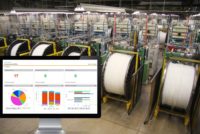Back on October 11 of this year, Bloomberg published an article by Julie Johnsson, Ryan Beene, Siddharth Vikram Philip, and Sabah Meddings, titled “Ghost in the Machine: How Fake Parts Infiltrated Airline Fleets.”
The article detailed how a London distributor sold fake engine parts with bogus documentation. This allegation rose from what seemed like a rather routine encounter between a maintenance crew and these alleged fake components. The article stated:
“This spring, engineers at TAP Air Portugal’s maintenance subsidiary huddled around an aircraft engine that had come in for repair. The exposed CFM56 turbine looked like just another routine job for a shop that handles more than 100 engines a year. Only this time, there was cause for alarm.
“Workers noticed that a replacement part, a damper to reduce vibration, showed signs of wear, when the accompanying paperwork identified the component as fresh from the production line. On June 21, TAP pointed out the discrepancy to Safran SA, the French aerospace company that makes CFM engines together with General Electric Co.
Safran quickly determined that the paperwork had been forged. The signature wasn’t that of a company employee, and the reference and purchase order numbers on the part also didn’t add up.”
This, naturally, set off an investigation into the components and the distributor that, as of the date of the article, had Safran and GE to identify 90 falsified certificates and these bogus parts on some 126 engines.
The Bloomberg article also raised the question of “how an intensely regulated and safety-obsessed industry could be deceived by a single rogue outfit remains one of the big mysteries of the unfolding case.” It also briefly detailed that this is not the first time the aviation industry has had to deal with a bogus parts scandal, particularly when those parts have led to high-profile accidents. Most accounts at this stage seem to point to one small firm and one fraudster with what appears to be nothing more than a P.O. box in London having infiltrated the CFM network of distributors and manufacturers.
So, you may ask yourself, “How are we to guard against this kind of fraud?” The Bloomberg writers quoted Willie Walsh, director general of the International Air Transport Association. “What you need to do is know that your supply chain, the providers you’re dealing with, are reputable,” said Walsh. “It’s like anything: know who your partner is, know their track record, that they know who their partners are and that the chain is secure.”
John Vandenbemden simply poses, “Their selection of supplier B looks like a good choice. But is it?” In his column, he further writes, “Performance measures are not always what they appear. At times they reveal a hidden story that can only be found by peeling back the onion.”
So, read John’s column, “Performance Measures” and everything else we have to offer in this month’s Quality.
Enjoy and thanks for reading!




